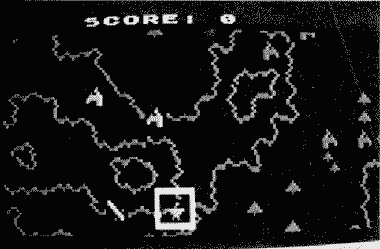The
War Zone
by Bob Cockroft
by Bob Cockroft
Legionnare by Chris Crawford is a game of ancient warfare which recreates the conflicts between Rome and the barbarian tribes of Gaul. The human player being Caesar, must be able to deploy and maneuver his legions in order to defeat the computer-controlled barbarian tribes. Fast-action battles provides not only an opportunity for strategic thinking, but also a truly entertaining experience. Like a good movie Legionnare has the ablity to captivate its audience with narrow escapes, daring maneuvers and military units with personality.
What makes this game different, realistic, and great, is the game operates in real-time. There is not any long boring turn sequences to go through, it all happens as if it would on the actual battle-field. Chris Crawford has used the same method of predetermined movement as he did in 'Eastern Front'. To set a route for a unit one first moves the joystick controlled square over a legion, then while pressing the button move the joystick in the direction you want the legion to move. This predetermined route can be as long as 8 spaces. After the direction of movement is assigned to a legion, it will automatically begin to travel down its route. Every legion is moved in the same way. However, at the same time the human player is giving orders to his legions, the computer is moving or possibly attacking with his barbarian tribes. Therefore, using this method game turns are eliminated and the speed of play is accelerated. In fact, the human player often does not have time to execute detailed and complex strategies. This is a game where only a quick and pragmatic commander will succeed.
The graphics in this game has to be a disappointment. Chris Crawford after setting the standard of graphics in war-games with Eastern Front, has seemed to take a step backward. Although the screen scrolls both horizontally and vertically, the scenery is not done with the detail or care that would be expected from this programmer. The mountains are displayed using the topographical method. However, the topographical lines are too thick, making the background look second class. The graphics of the military units can best be describe e as adequate, but not entertaining. The infantry unites, for example, are displayed as a sword standing up-right. This type of uninspiring presentation does not exploit the graphic capabilities of the Atari computer. The over all presentation of Legionnare reveals that the graphics were not made with the care or detail they could have been.
This game is reasonable but not overly flexible. Although the human player is confined to commanding only the Rome legions, a wide variation of skill levels have been developed. By choosing which barbarian tribe you are wanting to fight, numerous scenerios can be created. From the ineffective tribes like the Aedui and the Auscu to the most dangerous Helvetu and Huns, competitive situation can be created for even the most skillful war-gamers. The number of legions under the human players command is also seleclable. Although there is no way to select which particular legions you wish to have in your army, arnywhere from one to ten legions can be chosen.

An important aspect that makes this game entertaining is that each legion has its own particular characteristics. Unlike many war-games where units of a particular class have uniform characteristics, in this game every legion and barbarian tribe has its owns personality. In addition to providing more realism, individuality allows further strategy. For example, a unit like Plancus legion would be less suited for an offensive role than Galba's legion. With time, one becomes accustomed with the strengths and weaknesses of each legion. A personality of your fighting force develops. You begin to know each of the legions the same way you would know each one of your friends. Familiarity adds to an entertaining qualities of this game.
One problem I have had with many war-games in the past is that the design only allowed for a few or sometimes one practical strategy to exist. A game of this type seems to develop basically the same way every time one plays it. Legionare does not have this problem because your legions are randomly placed on the playfield and the enemy does not always come from the same direction. Each tribe has its own characteristic, therefore they all cannot be handled in the same way. The result is each game is a totally different battle. After playing this game approximately ten times, I have never had the same battle twice.
Legionnaire is a revolutionary new war-game. By using real time instead of the tradition turn-sequence not only is the advantage of the computer over board games exploited, but has opened a totally new field in war-games. Despite the questionable graphics, I found this game very enjoyable. It is flexible and the basic design seemed to promote both interesting and varied strategies. Although this game has some weaknesses, it is quite exciting and would be one I would recommend. Next issue 'Nato Commander' from MicroProse Software will be reviewed.
The Avalon Hill Game Co.
4517 Harford Road
Baltimore, MD 21214
Legionnaire
Graphics:7.7
Challenge:9.5
Documentation:9.8
Strategic Value:8.4
Excitement:8.4
Realism:8.2
Use of Computer:8.5
Overall:8.6
4517 Harford Road
Baltimore, MD 21214
Legionnaire
Graphics:7.7
Challenge:9.5
Documentation:9.8
Strategic Value:8.4
Excitement:8.4
Realism:8.2
Use of Computer:8.5
Overall:8.6